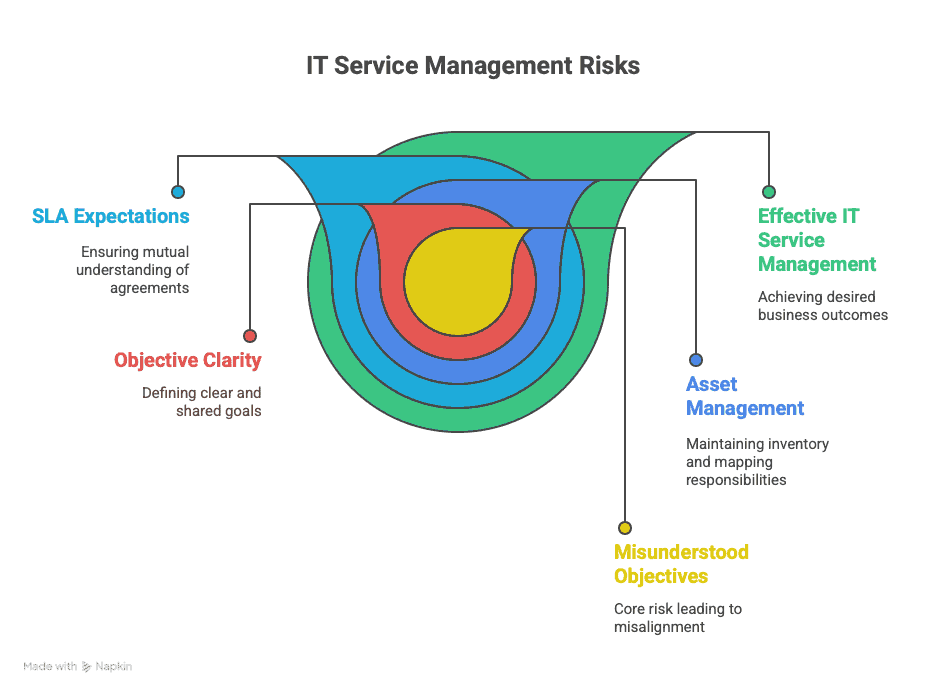
The SLA Trap: IT Managed Services Challenges Hidden in the Fine Print
IT managed services challenges often hide behind glowing dashboards and cheerful monthly reports. Everything looks fine until nothing works.
From “unlimited support” that suddenly becomes very limited to SLAs that define uptime without defining ownership, these challenges are less about tech and more about clarity, control, and contracts that actually mean something.
64% of Americans don’t know what steps to take in the event of a data breach. That’s not just a public awareness issue – it’s a direct reflection of how service providers set expectations and train end users. If the breach plan is “call support and hope for the best,” you don’t have a partner. You have a help desk with branding.
Chris Butler, executive VP at IP Services, says, “A service is only managed if someone is clearly responsible when it fails.” This blog examines the structural cracks in many provider relationships, including unclear deliverables, reactive support, and responsibilities that disappear the moment action is needed.
Expect practical guidance on how to spot risk, write smarter contracts, and choose a provider who can think as strategically as you do.
Where IT Managed Services Challenges Begin: Misalignment at the Starting Line
Most IT managed services challenges don’t appear overnight – they grow quietly from the earliest decisions. When businesses rush into contracts without clearly defined goals or boundaries, it sets the stage for long-term inefficiency. This section addresses the early-stage oversights that create friction later.
1. Misunderstood Objectives Multiply Risk
When IT goals are vaguely outlined or left to the provider’s discretion, misalignment often results.
- Always align services with business outcomes, not just technical capabilities.
- Avoid assuming shared understanding; clarify metrics before engagement begins.
- Don’t let tech-led language replace operational clarity.
2. Scattered Assets Lead to Inconsistent Delivery
Without a complete inventory and infrastructure map, support will be reactive rather than strategic.
- List every existing system, license, and vendor-managed tool.
- Identify outdated, duplicated, or shadow IT resources.
- Map responsibilities internally before introducing third-party support.
3. SLA Expectations Are Often One-Sided
A service level agreement is only effective if both sides interpret it the same way.
- Clarify resolution timelines versus response times.
- Define what constitutes success for both ongoing support and project-based tasks.
- Confirm reporting cadence and escalation processes in writing.

Small businesses are 350% more susceptible to phishing attacks than large businesses. That’s a risk magnifier when onboarding is unclear or security responsibilities are assumed instead of confirmed. Early miscommunication creates long-term exposure.?
The Financial Fallout of Overlooking Managed Services Challenges Early On
Once in place, managed services challenges don’t just slow operations – they drain budgets quietly. Companies often underestimate the compounding financial impact of slow resolutions, unclear scopes, and service gaps. This section outlines how early oversights evolve into measurable losses.
1. Untracked Support Volume Hides Escalating Cost
Most businesses don’t realize how many hours are spent on “minor” issues.
- Review service reports monthly and compare tickets to business impact.
- Measure time lost per ticket, not just volume.
- Calculate the cost of repeat incidents that point to deeper issues.
2. Scope Drift Bloats the Invoice
A vague contract often turns into an open wallet. As services expand without oversight, so does spending.
- Set service boundaries and revisit them quarterly.
- Track add-ons, escalations, and out-of-scope tasks.
- Use these data points to renegotiate terms or escalate internally.
3. Overdependence on Vendor-Led Tools Can Limit Flexibility
If the entire stack is chosen or managed by your MSP, costs can spike without control.
- Audit tool usage regularly to ensure it serves business outcomes.
- Identify where vendor preferences may conflict with or compromise fit or efficiency.
- Build an internal review rhythm for third-party dependencies.
The average Spend per Employee in the Managed Services market is projected to reach US$6.87 in 2024. Without precise financial tracking, this investment can turn from value into overhead, especially for organizations growing fast or scaling support needs.
How to Spot a Failing IT Managed Services Provider Before It’s Too Late
Not all problems with an IT managed services provider show up in service tickets. Decline tends to reveal itself through softer signs: friction in communication, a lack of follow-through, or growing silence where strategic input used to be present.
The earlier you recognize these patterns, the easier they are to correct.
1. Support Starts Feeling Like a Transaction
When communication becomes strictly reactive, value starts to erode.
- Templated updates replace strategic check-ins.
- The provider stops asking about your goals or internal changes.
- Suggestions become generic, rather than tailored to your specific environment.
2. Outcomes Stop Improving, but the Metrics Look Fine
An MSP may hit SLA targets while failing to deliver meaningful results.
- Review whether time-to-resolution has improved outcomes or just cleared queues.
- Examine whether “green” dashboards reflect actual productivity or business value.
- Check if issues are repeating – resolution is not the same as prevention.
A disengaged IT managed services provider often looks reliable on paper, but ineffective in practice. The difference lies in initiative, accountability, and whether they continue to act like stakeholders or merely another vendor.
Behavior Patterns: Healthy vs. Failing IT Managed Services Provider
| Indicator | Healthy Provider | Failing Provider |
| Engagement Rhythm | Proactively schedules reviews tied to business cycles | Only contacts you when there’s an issue or renewal approaching |
| Strategic Involvement | Contributes to IT planning, budgeting, and roadmap development | Absent from strategic conversations; sticks strictly to reactive support |
| Problem Resolution | Addresses root cause and shares prevention steps | Fixes symptoms repeatedly with no lasting change |
| Reporting Quality | Delivers insights tied to outcomes, risks, and optimization | Sends generic logs or surface-level metrics with no interpretation |
| Adaptability to Change | Adjusts services as your business evolves | Keeps the same approach regardless of team size, tools, or workflow changes |
| Innovation Input | Brings unsolicited recommendations that reduce cost or improve operations | Waits for you to raise problems before offering ideas |
Redefining the Relationship: Turning Managed Services Challenges into Strategic Wins
Once managed services challenges are exposed, the real opportunity begins. These issues don’t always require switching providers; often, they reveal the need to restructure expectations, improve communication, and recalibrate the service focus. This section explores how to rebuild the relationship for measurable value.
1. Clarify Ownership Before It’s Tested Again
Service friction usually stems from overlapping or unassigned responsibilities.
- Map operational responsibilities by function: security, compliance, data backups, patching, etc.
- Identify areas of dual ownership and document escalation paths.
- Establish a cadence for joint reviews of unresolved items.
2. Rethink Reporting as a Business Tool
Reports should do more than just show activity; they should inform decisions.
- Replace volume-based reporting with insights tied to business KPIs.
- Add narrative context to trends: What changed, why, and what’s next.
- Use service data to prioritize budget, upgrades, and user training.
3. Embed Accountability into Every Service Layer
The absence of friction doesn’t always mean success. Accountability must be embedded, not assumed.
- Align service reviews with specific deliverables, not just satisfaction scores.
- Document missed expectations and link them to outcomes, not just responses.
- Require transparent tracking of previously raised issues.
4. Build Flexibility into the Relationship
A rigid agreement is a fragile one. Long-term value comes from shared adaptability.
- Include language for quarterly service realignment without contractual penalties.
- Define scalable service tiers that adapt to changes in hiring or infrastructure.
- Set review points triggered by specific business events (e.g., acquisition, compliance audits).
Solving managed services challenges requires more than patching gaps. It takes an intentional redesign of how service is measured, delivered, and adapted to the business it serves.
What the Right IT Managed Services Provider Looks Like in Practice
Choosing an IT managed services provider shouldn’t feel like gambling with uptime. The best providers are defined by how they think, plan, and execute – not by how fast they answer tickets. This section outlines what high-functioning, forward-thinking support looks like in real-world business settings.
1. Strategic Insight Comes Standard
Great providers don’t wait to be asked for input – they operate as an extension of your leadership team.
- They bring proactive recommendations tied to upcoming industry shifts or internal scaling needs.
- They understand your growth trajectory and suggest systems that match, not just what’s easy to deploy.
- Their team can discuss the business impact, not just the backend infrastructure.
2. Flexibility Is Built Into the Model
Adaptability isn’t a bonus – it’s a requirement for supporting modern businesses.
- Their contracts allow for service adjustments without heavy penalties.
- Service tiers scale in sync with staff or infrastructure changes.
- They offer clear paths for both expanding and reducing scope as needed.
A great IT managed services provider isn’t just capable – they’re aligned. They bring consistency, clarity, and forward-thinking execution that drives results you can measure.
IP Services – Ready for Smarter Support That Moves With Your Business?
We don’t sell checklists – we solve the problems that block performance. Our approach is structured, measurable, and designed to evolve in line with your priorities.
Contact us today to rethink what managed IT should mean.


